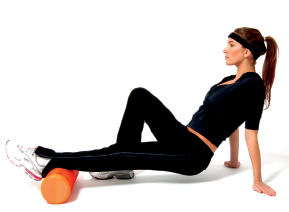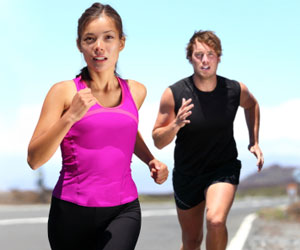The first time I heard the term ‘foam rolling,’ I thought it was some kind of tantric act practiced in far-off Eastern cultures. Come to find out, it’s a deep stretching method used by frequent runners. Hmm, guess I was way off. 
To channel my inner running addict and discover everything I need to know about this foam rolling practice, I’ve summoned the help of one of the fitness industry’s foremost running experts: ExerciseTV celebrity trainer and New Balance Fitness Ambassador, Holly Perkins.
What is foam rolling?
Foam rolling, in essence, is self massage. It is a mechanical way to improve myofascial release, which means that the muscle tissue will be released, restored and therefore, better able to recover. While running can be a perfectly healthy sport, often the structural personality of the runner spells muscle imbalances. Foam rolling helps to restore the balance of opposing muscle groups which tug and pull against each other. In short, it releases the particular muscle so that it can then contract more effectively. Foam rolling also helps to release any pulling by muscles and tendons on joints such as the hips and knees.
What do beginners need to know?
Beginners to foam rolling need to know to start gently! If your muscles are tight and you have been training hard, your muscle may scream when you begin rolling. Start with a moderate amount of pressure so that you’re able to relax into the massage. It may be a bit uncomfortable, but try to relax into it. This mind-body connection means that your muscles will relax better when the mind and the foam roller work together. The key muscle areas in runners that benefit most from foam rolling are: quadriceps, hamstrings, glutes, outer areas of hip and glutes, IT Band (the sides of your thighs), and inner thighs. Try foam rolling these areas to see which are tight for you. Everyone has different needs when it comes to foam rolling.
 Who does it?
Who does it?
Foam rolling is used religiously by professional athletes, trainers and physical therapists. When this many high level pros are using a tool, you know it works. Often injuries occur because a joint is being pulled or pushed in a direction that is out of balance with what’s intended. Foam rolling helps to release the inaccurate pulling so that the joint is free to move about its intended range of motion. Another common source of injury is tight or impaired muscle function. Foam rolling helps to release the incasement around a muscle so that it’s relaxed and able to do its job.
Where can I buy one?
Foam rollers are very popular these days and you can find them at most sporting goods stores and online. Your local fitness center most likely has them as well. If you are in a small town or rural area, your local physical therapist will have one. Most foam rollers are very economical and inexpensive.
What other tools/activities give similar results?
While foam rolling is a gold standard, runners can and should use other recovery tools as well. Stretching sessions that are after or away from workouts help to improve flexibility and foster recovery. Icing and ice baths are both hugely effective and often overlooked. Try an ice bath after your next long run and see how you feel the next day. Most runners agree that the second day “trauma” from a long run is significantly reduced.
Also Read:
Barefoot Running Gains Popularity
Importance of Fueling Up Before a Workout
Beginner’s Guide to Barefoot Running
photo via yunbootcamps.com
